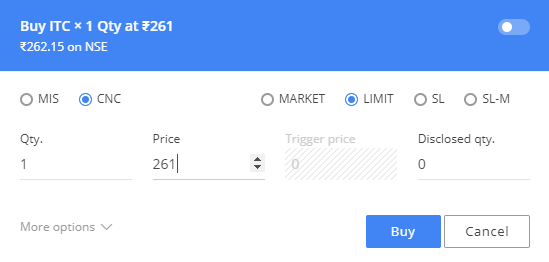Our objective is to purchase 1 share of ITC. We now have ITC in our buying and selling terminal, and we’re satisfied that purchasing ITC at Rs.261, which is roughly Rs.1.25 lesser than the last traded price is a great idea.
The first step for this process would be to invoke what is known as a buy order type.
- Hover over the stock you wish to Buy and click on on the Buy Icon(B)
- This will invoke the Buy. When the purchase order type is invoked, the next order form will appear on your display screen.
Also Read – How to Apply an IPO through Zerodha?
The order type is pre-populated with some information like the price and quantity. We need to modify this as per our requirement. Let us start by the primary drop-down option on the top. By default, the exchange specified can be NSE.
The subsequent entry is the ‘order type’. By clicking on the drop-down menu, you will note the next 4 options:
- Limit
- Market
- SL
- SL-Market
Let us understand what these choices truly imply.
You can go for a ‘Limit’ order when you’re very specific in regards to the price you wish to pay for a stock. In our case, the last traded price of ITC is Rs.262.25 however say we wish to restrict our purchase price to Rs.261. In such a scenario where we’re specific in regards to the price we wish to transact in, we will limit order price. If the value doesn’t fall to Rs.261, then you’ll not get the shares. This is without doubt one of the drawbacks of a limit order.
You may also go for a Market Order if you intend to purchase at market available prices instead of a concrete price that you’ve got in mind. So for those who have been to position a market order, as long as there are sellers available, your order would undergo, and ITC will probably be purchased within the vicinity of Rs.262.25. Suppose the value goes as much as Rs.265 coinciding together with your market order placement, then you’ll get ITC at Rs.265. When you place a market order, you’ll by no means be sure of the value at which you’d transact, which may very well be fairly a harmful scenario in case you are an active trader.
A Stop-Loss Order protects you from an adverse movement in the market after initiating a position. Suppose you purchase ITC at Rs.262.25 with an expectation that ITC will hit Rs.275 shortly. But as an alternative, what if the value of ITC begins going down? We can first shield ourselves by defining the worst potential loss you’re keen to take. For instance, within the instance allow us to assume you don’t wish to take a loss beyond Rs.255
This means you’ve got gone long on ITC at Rs.262.25 and the utmost loss you’re keen to take on this trade is Rs.6 (255). If the stock worth drops all the way down to Rs.255, the stop loss order will get active and hits the trade, and you may be out of the loss-making position. As long as the value is above 255, the stop-loss order will probably be dormant.
A stop-loss order is a passive order. To activate it, we have to enter a trigger price. A trigger price, often above the stop-loss price acts as a price threshold and solely after crossing this worth the stop-loss order transitions from a passive order to an active order.
Quick Note: Looking for the very best Demat and Trading account to begin your investing journey? Click here to open your account with one of the Stockbroker in India — Join Millions of Investors & Traders, Zero Brokerage on investing in shares and mutual funds, Instant Paperless on-line account opening. Start Now!!
Going with the above instance:
We are long at Rs.261. In case the trade goes dangerous, we’d wish to get rid of the position at Rs.255. Therefore 255 is the stop-loss price. The trigger price is specified in order that the stop-loss order would transition from passive to an active order. The trigger price needs to be greater/equal than the stop-loss price. We can set this to Rs.255 or greater. If the value drops under 255, the stop loss order gets active.
Going again to the main buy order entry type, we now move on to the quantity as soon as the order type is chosen. Remember the task is to purchase 1 share of ITC;
Therefore we enter 1 within the quantity field. We ignore the trigger price and disclosed quantity for now. The subsequent thing to pick out can be the product type.
Select CNC for delivery trades. If you plan to purchase and maintain the shares for multiple days/months/years, you might want to make sure the shares reside in your Demat account. Selecting CNC is your way of communicating this to your broker.
Select NRML or MIS if you wish to trade intraday. MIS is a margin product; we’ll understand more about this once we take up the derivatives module.
Once these particulars are filled in your order type, the order is good to hit the markets. The order will get transmitted to the exchange as soon as you press the submit button on the order type. A unique order ticket number is generated against your order.
Once the order is sent to the exchange, it won’t get executed until the value hits Rs.261. As quickly as the value drops to Rs.261 (and assuming sellers are willing to sell 1 share) your order gets through and is ultimately executed. As quickly as your order is executed, you’ll own 1 share of ITC.

